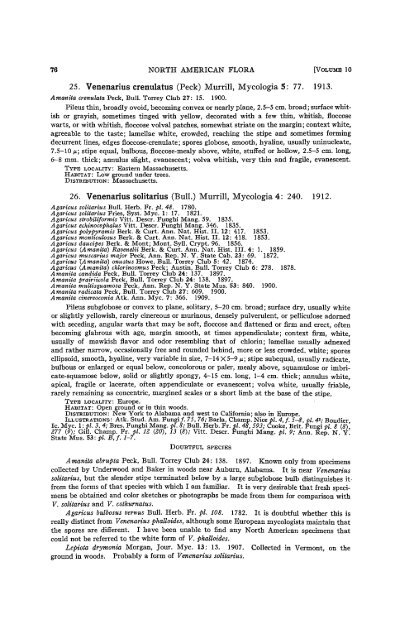North American Flora: Agaricales, Agaricaceae (Vol. 10 ... - MykoWeb
North American Flora: Agaricales, Agaricaceae (Vol. 10 ... - MykoWeb
North American Flora: Agaricales, Agaricaceae (Vol. 10 ... - MykoWeb
Create successful ePaper yourself
Turn your PDF publications into a flip-book with our unique Google optimized e-Paper software.
76 NORTH AMERICAN FLORA [VOLUME <strong>10</strong><br />
25. Venenarais crenulatus (Peck) Murrill, MycologiaS: 77. 1913.<br />
Amanita crenulata Peck, Bull. Torrey Club 27: IS. 1900.<br />
Pileus thin, broadly ovoid, becoming convex or nearly plane, 2.5-5 cm. broad; surface whit-<br />
ish or grayish, sometimes tinged with yellow, decorated with a few thin, whitish, floccose<br />
warts, or with whitish, floccose volval patches, somewhat striate on the margin; context white,<br />
agreeable to the taste; lamellae white, crowded, reaching the stipe and sometimes forming<br />
decurrent lines, edges floccose-crenulate; spores globose, smooth, hyaline, usually uninucleate,<br />
7.5-<strong>10</strong> M; stipe equal, bulbous, floccose-mealy above, white, stuffed or hollow, 2.5-5 cm. long,<br />
6-8 mm. thick; annulus slight, evanescent; volva whitish, very thin and fragile, evanescent.<br />
TYPE LOCALITY: Eastern Massachusetts.<br />
HABITAT: LOW ground under trees.<br />
DISTRIBUTION: Massachusetts.<br />
26. Venenarais solitarius (Bull.) Murrill, Mycologia 4: 240. 1912.<br />
Agaricus solitarius Bull. Herb. Fr. pi. 48. 1780.<br />
Agaricus solitarius Fries, Syst. Myc. 1: 17. 1821.<br />
Agaricus strobiliformis Vitt. Descr. Funghi Mang. 59. 1835.<br />
Agaricus echinocephalus Vitt. Descr. Funghi Mang. 346. 1835.<br />
Agaricus polypyramis Berk. & Curt. Ann. Nat. Hist. II. 12: 417. 1853.<br />
Agaricus monliculosus Berk. & Curt. Ann. Nat. Hist. II. 12: 418. 1853.<br />
Agaricus daucipes Berk. & Mont; Mont. Syll. Crypt. 96. 1856.<br />
Agaricus {Amanita) Ravenelii Berk. & Curt. Ann. Nat. Hist. III. 4: 1. 1859.<br />
Agaricus muscarius major Peck, Ann. Rep. N. Y. State Cab. 23: 69. 1872.<br />
Agaricus \Amanita) onustus Howe, Bull. Torrey Club 5: 42. 1874.<br />
Agaricus {Amanita) chlorinosmus Peck; Austin, Bull. Torrey Club 6: 278. 1878.<br />
Amanita candida Peck, Bull. Torrey Club 24: 137. 1897.<br />
Amanita prairiicola Peck, Bull. Torrey Club 24: 138. 1897.<br />
Amanita multisquamosa Peck, Ann. Rep. N. Y. State Mus. S3: 840. 1900.<br />
Amanita radicata Peck, Bull. Torrey Club 27: 609. 1900.<br />
Amanita cinereoconia Atk. Ann. Myc. 7: 366. 1909.<br />
Pileus subglobose or convex to plane, solitary, 5-20 cm. broad; surface dry, usually white<br />
or slightly yellowish, rarely cinereous or murinous, densely pulverulent, or pelliculose adorned<br />
with seceding, angular warfs that may be soft, floccose and flattened or firm and erect, often<br />
becoming glabrous with age, margin smooth, at times appendiculate; context firm, white,<br />
usually of mawkish flavor and odor resembling that of chlorin; lamellae usually adnexed<br />
and rather narrow, occasionally free and rounded behind, more or less crowded, white; spores<br />
ellipsoid, smooth, hyaline, very variable in size, 7-14X5-9 ¿i; stipe subequal, usually radicate,<br />
bulbous or enlarged or equal below, concolorous or paler, mealy above, squamulose or imbri-<br />
cate-squamose below, solid or slightly spongy, 4-15 cm. long, 1-4 cm. thick; annulus white,<br />
apical, fragile or lacerate, often appendiculate or evanescent; volva white, usually friable,<br />
rarely remaining as concentric, margined scales or a short limb at the base of the stipe.<br />
TYPE LOCALITY: Europe.<br />
HABITAT: Open ground or in thin woods.<br />
DISTRIBUTION: New York to Alabama and west to California; also in Europe.<br />
ILLUSTRATIONS: Atk. Stud. Am. Fungi/. 75, 76; Baria, Champ. Nice pi. 4,f. 5-8, pi. 4*; Boudier<br />
Ic. Myc. I: pi. 3, 4; Bres. Funghi Mang. pi. 8; Bull. Herb. Fr. pi. 48, 593; Cooke, Brit. Fungi pi 8 ¡8)<br />
277 (0); Gill. Champ. Fr. pi. 12 (20), 13 (.8); Vitt. Descr. Funghi Mang. pi. 9; Ann. Rep N Y<br />
State Mus. S3: pi. B, f. 1-7.<br />
DOUBTFUL SPECIES<br />
Amanita abrupta Peck, Bull. Torrey Club 24: 138. 1897. Known only from specimens<br />
collected by Underwood and Baker in woods near Auburn, Alabama. It is near Venenarius<br />
solitarius, but the slender stipe terminated below by a large subglobose bulb distinguishes it'<br />
from the forms of that species with which I am familiar. It is very desirable that fresh speci-<br />
mens be obtained and color sketches or photographs be made from them for comparison with<br />
V. solitarius and V. cothurnatus.<br />
Agaricus bulbosus vernus Bull. Herb. Fr. pi. <strong>10</strong>8. 1782. It is doubtful whether this is<br />
really distinct from Venenarius phalloides, although some European mycologists maintain that<br />
the spores are different. I have been unable to find any <strong>North</strong> <strong>American</strong> specimens that<br />
could not be referred to the white form of V. phalloides.<br />
Lepiota drymonia Morgan, Jour. Myc. 13: 13. 1907. Collected in Vermont, on the<br />
ground in woods. Probably a form of Venenarius solitarius.
















